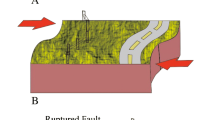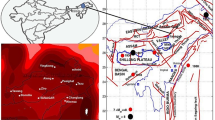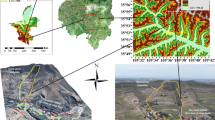Abstract
At 12:52 (local time, UTC + 08:00) on September 5, 2022, an earthquake of magnitude 6.6 occurred in Luding of the Sichuan Province (southwest China). Combined with the empirical relationship between magnitude and global–local source parameters, the hybrid source model of the Luding earthquake was applied. In a simulation, the source model was mainly described by global source parameters and local source parameters. Based on the empirical relationship between global source parameters and magnitude, we obtained the mean values of global source parameters. In combination with the standard deviation given by the empirical formula, the source parameters satisfying the mean value and standard deviation were generated based on the modified truncated normal distribution function. The observation points were selected considering the various geological conditions and orientations, and then, they were generated based on the acceleration waveforms of the selected observation points using the finite-fault approach through the dynamic corner frequency. Next, their values were used to calculate the acceleration response spectra of these target points. Then, the source model corresponding to the 5% damped pseudospectral acceleration (PSA) with the minimum residual of the average response spectra was selected and is finally set as the optimal source model for the Luding earthquake in China. Finally, the slip distributions of two models were compared, the response spectra were obtained, and the impacts of the two source models on the simulation results were investigated. The results verified the reliability of the source model estimated in this study and showed that the influence of the source model on the simulation results is mainly present in the short period. In addition, the results indicate that the method obtained in this study can be used to quickly predict the source model for earthquake scenarios.













Similar content being viewed by others
Data availability
The commonly used EXSIM Fortran program is available from the website: https://www.daveboore.com/software_online.html (last accessed September 2018). Some parameters required for the ground motion simulation were collected from Han et al. (2022). The data supporting the funding of this study are available from the Institute of Engineering Mechanics, China Earthquake Administration upon reasonable request.
References
Andrews DJ (1981) A stochastic fault model: 2 time-independent case. J Geophys Res 86:10821–10834
Atkinson GM, Boore DM (1995) Ground-motion relations for eastern North America. Bull Seismol Soc Am 85:17–30
Beresnev IA (2001) What we can and cannot learn about earthquake sources from the spectra of seismic waves. Bull Seismol Soc Am 91:397–400
Beresnev IA, Atkinson GM (1998) Stochastic finite-fault modeling of ground motions from the 1994 Northridge, California, earthquake. I. Validation on rock sites. Bull Seismol Soc Am 88:1392–1401
Boore DM (1983) Stochastic simulation of high-frequency ground motions based on seismological models of the radiated spectra. Bull Seismol Soc Am 73:1865–1894
Boore DM (2003) Simulation of ground motion using the stochastic method. Pure Appl Geophys 160:635–676
Boore DM, Joyner WB (1997) Site amplifications for generic rock sites. Bull Seismol Soc Am 87:327–341
Dang PF, Liu QF, Ji LJ, Wang C (2020) Simulation of finite fault hybrid source models for the Mw 6.6 Jiuzhaigou, China, earthquake. J Seismolog 24:1255–1265
Dang PF, Wang C, Qi WH, Li YD (2022a) An updated stochastic finite fault modeling: application to the Mw 6.0 earthquake in Jiashi, China. Soil Dyn Earthq Eng 162:107450
Dang PF, Cui J, Liu QF (2022b) Parameter estimation for predicting near-fault strong ground motion and its application to Lushan earthquake in China. Soil Dyn Earthq Eng. 156:107223
Dang PF, Cui J, Liu QF (2022c) Site amplification and rupture velocity in EXSIM and updated EXSIM during the 2017 Mw 6.6 Jiuzhaigou China earthquake. Nat Hazards 116(1):1105–1123
Dang PF, Cui J, Liu QF, Ji LJ (2023) A method for predicting hybrid source model of near-field ground motion: application to Yangbi earthquake in China. Seismol Res Lett 94(1):189–205
Dimitriadis P, Koutsoyiannis D (2015) Climacogram versus autocovariance and power spectrum in stochastic modelling for Markovian and Hurst-Kolmogorov processes. Stoch Env Res Risk Assess 29(6):1649–1669
Gallovič F, Brokešová J (2004) On strong ground motion synthesis with k-2 slip distributions. J Seismolog 8(2):211–224
Gnedenko BV, Kolmogorov AN (1949) Predelnye raspredelniya dlya summ nezavisimykh sluchainykh velichin (Limit distributions for sums of independent random variables). Gostekhizdat, Moscow-Leningard (in Russian)
Han BQ, Liu ZJ, Chen B, Li ZH, Yu C, Zhang Y, Peng JB (2022) Coseismic deformation characteristics of the 2022 Luding Mw 6.6 earthquake from InSAR and rupture slip distribution. Geomat Inf Sci Wuhan Univ. https://doi.org/10.13203/j.whugis20220636.(inChinese)
Hanks TC, Kanamori H (1979) A moment-magnitude scale. J Geophys Res 84:2348–2350
Hisede Y (2001) A theoretical omega-square model considering the spatial variation in slip and rupture velocity. part 2: case for a two-dimensional source model. Bull Seismol Soc Am 91:651–666
Jiang W, Li ZY (2023) Estimation of the finite fault source model for the 2018 Mw 7.1 Acari, Peru earthquake using a hybrid simulation prediction approach. Soil Dyn Earthq Eng 164:107613
Jiang W, Tao XX, Zhao K (2017a) Scaling laws of the global parameters of source models from NGA data. Chin Earthq Eng J 39:221–226 ((in Chinese))
Jiang W, Tao XX, Tao ZR, Cao ZL, Wang LY (2017b) Scaling laws of local parameters of finite fault source model. Earthq Eng Eng Dyn 37:23–30 ((in Chinese))
Koutsoyiannis D (2022) Stochastics of Hydroclimatic extremes–A cool look at risk, Edition 2. Kallipos Open Academic Editions, Athens
Liu HM, Tao XX (2013) Source model of the great Wenchuan earthquake 8.0 for synthesis of strong ground motion. Chin Civil Eng J 46:139–145 ((In Chinese))
Meneisy AM, Toni M, Omran AA (2020) Soft sediment characterization using seismic techniques at Beni Suef city. Egypt J Environ Eng Geophys 25:391–401
Mitchell BJ (1995) Anelastic structure and evolution of the continental crust and upper mantle from seismic surface wave attenuation. Rev Geophys 33:441–462
Motazedian D, Atkinson GM (2005) Stochastic finite-fault modeling based on a dynamic corner frequency. Bull Seismol Soc Am 95:995–1010
Nakamura T, Tsuboi S, Kaneda Y (2010) Rupture process of the 2008 Wenchuan, China earthquake inferred from teleseismic waveform inversion and forward modeling of broadband seismic waves. Tectonophysics 491:72–84
Olson AH, Aspel RJ (1982) Finite fault inverse theory with application to the 1979 Imperial Valley earthquake. Bull Seismol Soc Am 72:1969–2001
Ou JP, Wang GY (1998) Structural random vibration. National Defense Industry Press, Beijing
Sun XD, Wang G, Liu CQ (2013) Finite fault models of the Lushan earthquake made by using hybrid slip model. J Earthq Eng Eng Vib 33:15–20 ((in Chinese))
Tao XX, Anderson JG (2002) Near field strong ground motion simulation. Proc. of the ICANCEER 79–86.
Toni M (2017) Simulation of strong ground motion parameters of the 1 June 2013 Gulf of Suez earthquake. Egypt NRIAG J Astron Geophys 6:30–40
Wang HY, Tao XX (2004) Characterizing a shallow earthquake asperity model for predicting near field strong ground motion. J Harbin Inst Technol 37:1533–1539 ((in Chinese))
Wang HY (2004) Finite fault source model for predicting near-field strong ground motion. Harbin: Institute of Engineering Mechanics, China Earthquake Administration, Harbin. (in Chinese)
Wells DL, Coppersmith KJ (1994) New empirical relationships among magnitude, rupture length, rupture width, rupture area, and surface displacement. Bull Seismol Soc Am 84:974–1002
Zeng YH, Anderson JG, Guang Y (1994) A composite source model for computing realistic synthetic strong ground motions reference. Geophys Res Lett 21:725–728
Zhao K (2014) Scaling law of global parameters for the hybrid source model from NGA data, Harbin: Institute of Engineering Mechanics China Earthquake Administration, Harbin. (in Chinese)
Acknowledgements
The authors are thankful to the CSMNC for providing the Luding earthquake ground motion records. The authors would like to thank Bingquan Han, who is a doctoral student at the College of Geological Engineering and Geomatics, Chang’an University, for providing the inverted source data. The authors thank Linjian Ji, an employee of the Central and Southern China Municipal Engineering Design & Research Institute Co., Ltd, for providing simulation coda and all partners for their valuable comments. The AJE provides the language polishing services, and the authors would like to express their sincerely gratitude to AJE. Finally, the authors would like to express gratitude to the editors and two anonymous reviewers for their valuable comments.
Funding
This research was financially supported by the National Key Research & Development Program of China (Grant No. 2022YFC3003601), the Natural National Science Foundation for Young Scientists of China (Grant No. 42204050), the Postdoctoral Program of International Training Program for Young Talents of Guangdong Province, and the Postdoctoral Office of Guangzhou City, China (Grant No. 62216242).
Author information
Authors and Affiliations
Contributions
All authors contributed to the study conception and design. Material preparation, data collection and analysis were performed by PF Dang. The first draft of the manuscript was written by PF Dang and all authors commented on previous versions of the manuscript. All authors read and approved the final manuscript.
Corresponding author
Ethics declarations
Competing Interests
The authors have no relevant financial or non-financial interests to disclose.
Additional information
Publisher's Note
Springer Nature remains neutral with regard to jurisdictional claims in published maps and institutional affiliations.
Rights and permissions
Springer Nature or its licensor (e.g. a society or other partner) holds exclusive rights to this article under a publishing agreement with the author(s) or other rightsholder(s); author self-archiving of the accepted manuscript version of this article is solely governed by the terms of such publishing agreement and applicable law.
About this article
Cite this article
Dang, P., Cui, J., Li, Y. et al. Estimation of a hybrid slip model and its application to stochastic simulation of the Mw 6.6 earthquake on September 5, 2022, in Luding, China. Stoch Environ Res Risk Assess 37, 4175–4196 (2023). https://doi.org/10.1007/s00477-023-02500-6
Accepted:
Published:
Issue Date:
DOI: https://doi.org/10.1007/s00477-023-02500-6




